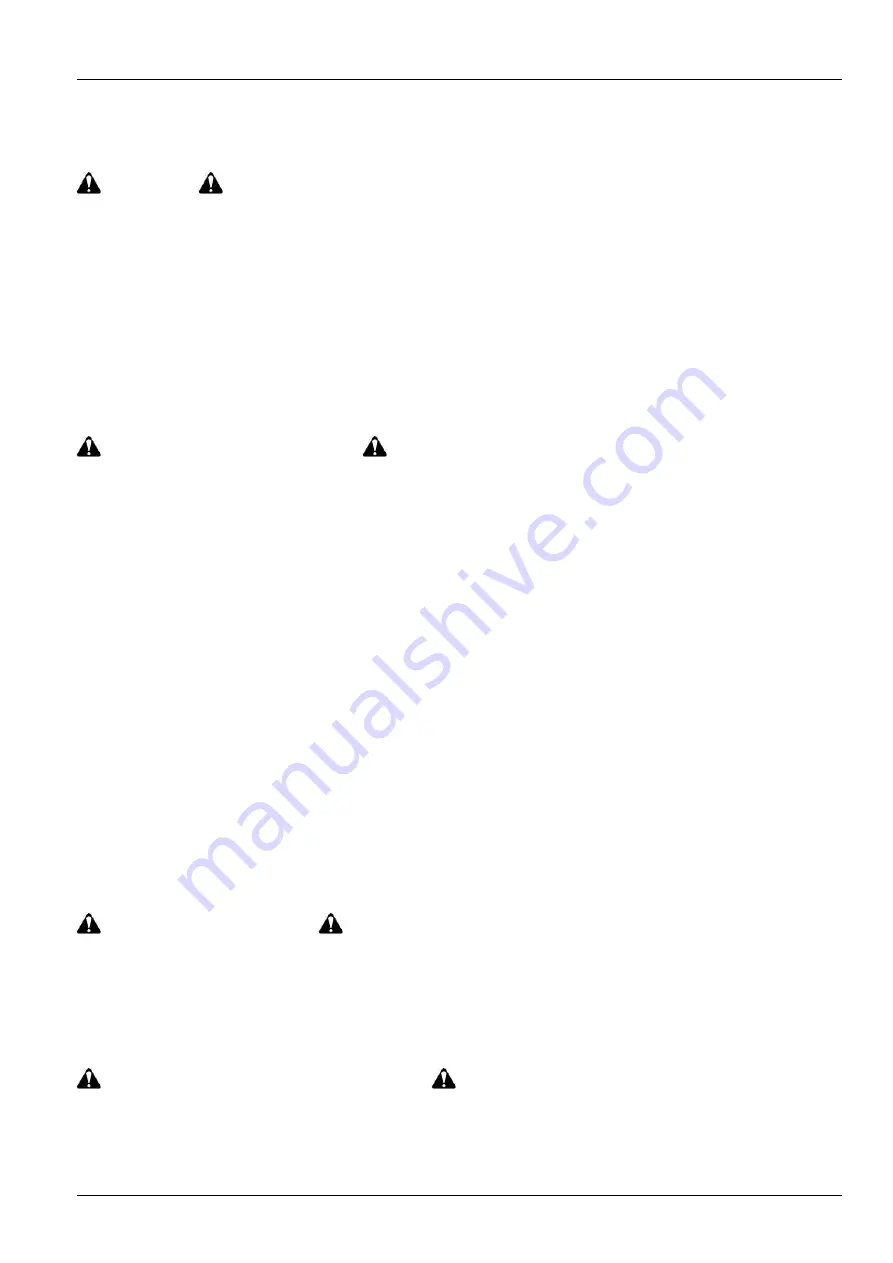
2 - SAFETY INFORMATION
Antidote (internal) : Drink large quantities of water or milk.
Do not induce vomiting. Seek medical attention immedi-
ately.
Keep out of reach of children and other unauthorized per-
sons.
Seat belts
Seat belts must be worn at all times.
Seat belt inspection and maintenance:
• Keep seat belts in good condition.
• Keep sharp edges and items than can cause damage
away from the belts.
• Periodically check belts, buckles, retractors, tethers,
slack take-up system, and mounting bolts for damage
and wear.
• Replace all parts that have damage or wear.
• Replace belts that have cuts that can make the belt
weak.
• Check that bolts are tight on the seat bracket or mount-
ing.
• If the belt is attached to the seat, make sure that the
seat or seat brackets are mounted securely.
• Keep seat belts clean and dry.
• Clean belts only with soap solution and warm water.
• Do not use bleach or dye on the belts because this can
make the belts weak.
Operator protective structure
Your machine is equipped with an operator protective
structure, such as:
a Roll Over Protective Structure
(ROPS), Falling Objects Protective Structure (FOPS),
or a cab with a ROPS. A ROPS may be a can frame
or a two-posted or four-posted structure used for the
protection of the operator to minimize the possibility of
serious injury.
The mounting structure and fasteners
forming the mounting connection with the machine are
part of the ROPS.
The protective structure is a special safety component of
your machine.
DO NOT attach any device to the protective structure for
pulling purposes. DO NOT drill holes to the protective
structure.
The protective structure and interconnecting components
are a certified system. Any damage, fire, corrosion, or
modification will weaken the structure and reduce your
protection. If this occurs, THE PROTECTIVE STRUC-
TURE MUST BE REPLACED so that it will provide the
same protection as a new protective structure. Contact
your dealer for protective structure inspection and re-
placement.
After an accident, fire, tip over, or roll over, the following
MUST be performed by a qualified technician before
returning the machine to field or job-site operations:
• The protective structure MUST BE REPLACED.
• The mounting or suspension for the protective struc-
ture, operator’s seat and suspension, seat belts and
mounting components, and wiring within the operator’s
protective system MUST be carefully inspected for
damage.
• All damaged parts MUST BE REPLACED.
DO
NOT
WELD,
DRILL
HOLES,
ATTEMPT
TO
STRAIGHTEN, OR REPAIR THE PROTECTIVE STRUC-
TURE. MODIFICATION IN ANY WAY CAN REDUCE
THE STRUCTURAL INTEGRITY OF THE STRUCTURE,
WHICH COULD CAUSE DEATH OR SERIOUS INJURY
IN THE EVENT OF FIRE, TIP OVER, ROLL OVER,
COLLISION, OR ACCIDENT.
Seat belts are part of your protective system and must be
worn at all times. The operator must be held to the seat
inside the frame in order for the protective system to work.
Air-conditioning system
The air-conditioning system is under high pressure. Do
not disconnect any lines. The release of high pressure
can cause serious injury.
The air-conditioning system contains gases that are
harmful to the environment when released into the atmos-
phere. Do not attempt to service or repair the system.
Only trained service technicians can service, repair, or
recharge the air-conditioning system.
Personal Protective Equipment (PPE)
Wear Personal Protective Equipment (PPE) such as hard
hat, eye protection, heavy gloves, hearing protection, pro-
tective clothing, etc.
2-5
Summary of Contents for E26C
Page 56: ...2 SAFETY INFORMATION 2 36 ...
Page 68: ...3 CONTROLS AND INSTRUMENTS Footrest SMIL19MEX0775BA 17 3 12 ...
Page 106: ...3 CONTROLS AND INSTRUMENTS 3 50 ...
Page 142: ...5 TRANSPORT OPERATIONS 5 8 ...
Page 218: ...6 MAINTENANCE 6 76 ...
Page 222: ...7 TROUBLESHOOTING 7 4 ...

































